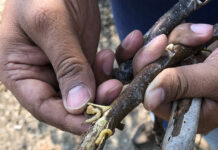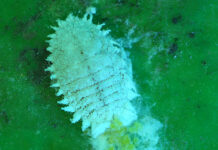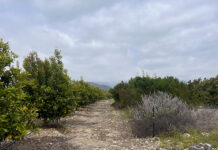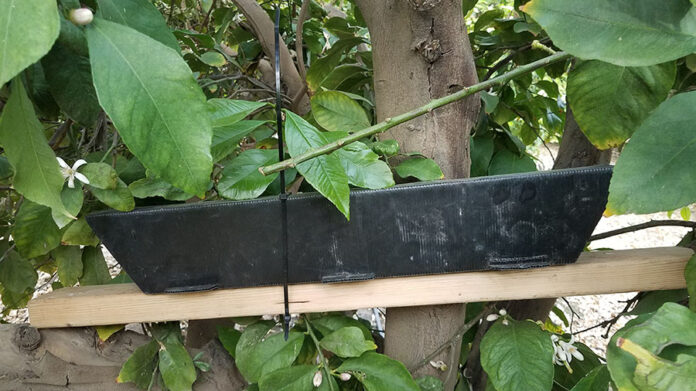
Roof rats (Rattus rattus) can cause extensive damage in citrus orchards through direct consumption of fruit, feeding of the cambium layer leading to mortality of branches, chewing on irrigation infrastructure and by posing as a potential food safety risk. The UC IPM Pest Management Guidelines for citrus (ipm.ucanr.edu/agriculture/citrus/Roof-Rats/) only list three management tools for roof rats: 1) cultural control, 2) rodenticide baiting and 3) trapping. Cultural control primarily involves removing vegetative materials from orchards to help deter roof rats, but the practicality of this approach is substantially limited in citrus given that the trees themselves provide ample cover for rats. This leaves rodenticides and trapping as the two primary tools for managing roof rats in citrus, although effective practices for each technique are unknown in citrus. Effective management of vertebrate pests also relies on quick and easy monitoring strategies to know when additional actions are needed to maintain low rodent density. Therefore, we initiated a series of studies in 2020 to develop an integrated pest management (IPM) program to manage roof rats in an efficacious and cost-effective manner. We summarize the findings from these studies in the following sections, ultimately providing a roadmap for an effective IPM approach for this invasive rodent pest.
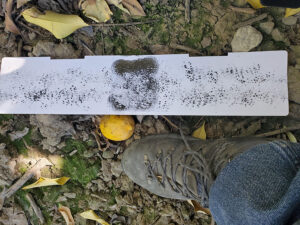
Monitoring
Effective management of all pests requires quick and easy monitoring strategies. We tested a strategy that used systematically placed tracking tunnels (Black Trakka, Gotcha Traps, or traps.co.nz) that contained a tracking card and ink pad to detect roof rat presence throughout orchards (tunnels tied to board placed up in tree; Fig. 1). When a rat visits the tunnel, it leaves ink footprints on the tracking card (Fig. 2). We determined one tracking tunnel approximately every 230 feet yielded an accurate estimate of current roof rat activity. A lure helps to draw rats into the tracking tunnel. We tested several options, including peanut butter, Liphatech Rat and Mouse AttractantTM and Liphatech NoToxTM wax blocks, and found all were equally effective. Given the ready availability and cheaper cost associated with peanut butter, it may be preferred by some, although the pre-packaged nature of the other attractants could make them desirable by users as well.
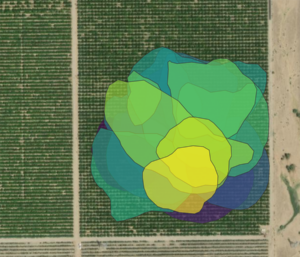
Movement Patterns
We knew little about how roof rats moved throughout citrus orchards. Such knowledge is important to determine where to target management strategies, to understand ideal spacing between traps and bait stations and to assess when roof rats were active in the orchards. To understand movement patterns in roof rats, we deployed a unique tracking system that used cellular technology to identify locations every few seconds. This allowed us to determine areas utilized by rats as well as how far they moved throughout the landscape. We determined roof rats exclusively used orchards (Fig. 3), indicating management efforts should be targeted within orchards rather than in adjacent habitats. We also determined roof rats had large home ranges that averaged 5.8 acres; minimum home range size was 1.8 acres. This equated to a radius of approximately 280 ft and 160 ft for average- and minimum-sized home ranges, respectively. This information is very valuable in determining ideal spacing between traps and bait stations to guarantee rat access to at least one of these management tools within their home range. We also used remote-triggered cameras to determine when roof rats were active within orchards. Based on photo data, roof rats were active exclusively at night, with activity often peaking around midnight. If necessary, roof rat removal efforts could be targeted exclusively at night to eliminate non-target effects to diurnal species (i.e., those active only during daytime), although such actions would likely be cost-prohibitive.
Test of Potential Management Tools
We focused our control efforts on the use of rodenticides and trapping as the only two techniques currently available that were likely to have a substantial impact on roof rat populations within citrus orchards. Previous research indicated the use of a 0.005% diphacinone-treated oat bait sold by many County Agricultural Commissioner’s offices in California (countyofkingsca.gov/home/showpublisheddocument/27503/637667104610630000) was effective at reducing roof rat populations when used in elevated bait stations (Fig. 4) within almond orchards. However, almond and citrus orchards are very different both in the cover provided by the trees as well as the food sources available. As such, we needed to test this product in citrus to determine its utility.
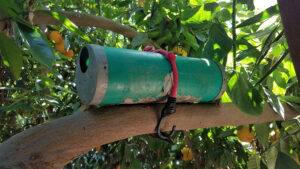
Effective IPM programs rely on more than one technique to safely and effectively manage pests. As such, we were interested in using trapping as an additional tool to manage roof rats. Historically, trapping in tree crops has relied on snap trapping, but snap traps are often viewed as too labor-intensive for use in production ag systems. The recent advent of the Goodnature® A24 trap had the potential to substantially reduce the amount of labor required to operate a trapping grid due to the long-lasting lure and use of a CO2 cartridge that would allow for use for four to six months without having to relure or reset the traps.
Regardless of the tool used, spacing between each subsequent bait station or trap was important to ensure success while minimizing cost. We originally established trapping and baiting grids where individual units were separated by approximately 250 feet. However, initial testing across three separate orchards indicated this spacing was not effective for bait stations (efficacy = 12%), so we reduced the spacing to 160 feet for the final orchard to mimic the minimum size of a roof rat home range. This spacing resulted in much higher efficacy (77%), and we planned to use that spacing moving forward. Likewise, we did not find the A24 trap to be effective at reducing roof rat activity across our first three study sites; in fact, we observed an increase in rat activity at these sites (efficacy = –70%). After consultation with staff from Goodnature®, we placed a platform underneath each trap to assist the rats in pushing far enough up into the trap to activate it (Fig. 5). This modification increased efficacy for our final site (50%), so we planned to add this adjustment in subsequent trials.
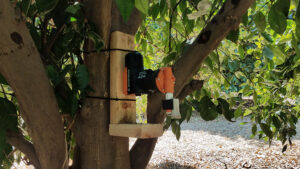
Develop and Test IPM Strategies
Taking information already learned, we developed an IPM strategy that used elevated bait stations at 160-foot spacing that contained 0.005% diphacinone-treated oats to initially knock down populations. Baiting typically lasted four weeks. We followed this up with two weeks of snap trapping using trapping tunnels tied to boards and placed in trees (Tomcat® Tunnel™ Trapping System, Motomco; Fig. 6). The trapping tunnels were targeted in areas with remaining rat activity to further reduce the population. Following completion of snap trapping, we deployed A24 traps for the remainder of a six-month period in an attempt to maintain low rat densities. We compared these results to that of a bait station-only approach (hereafter bait station) to determine which was most effective. Initial bait applications substantially reduced roof rat activity (efficacy = 73%), but neither the IPM nor bait station approaches adequately slowed reinvasion of the study sites (two-month post bait application efficacy: bait station = –5%, IPM = 13%; 5-month post bait application efficacy: bait station = 24%, IPM = 43%). As such, we developed a second IPM approach that again incorporated bait stations to knock down populations. We followed this up with a snap trapping program, again using trapping tunnels. For this approach, we spaced the trapping tunnels in a grid pattern with the traps 245 feet apart. These trapping tunnels were operated for the remainder of a six-month period. This approach was very effective, with rat activity decreasing over time (two-month post bait application efficacy: bait station = 34%, IPM = 88%; 5-month post-bait application efficacy: bait station = 85%, IPM = 93%). In total, we removed 97 rats via snap trapping in IPM plots during this part of the trial, again indicating the effectiveness of this approach. For bait station plots, rats quickly rebounded two months after the completion of the baiting program, indicating the IPM approach was more effective. Interestingly, rat populations again declined in the bait station plot for unknown reasons (no additional bait was used for the remainder of the study), although the IPM plots were always more effective. From an efficacy perspective, the IPM program was the better approach given the importance of using multiple tools to maintain long-term efficacy of management programs.
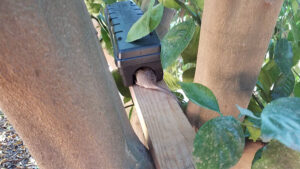
We also collected information on the cost of these management programs to better inform which were most practical. The IPM plots that used A24 traps were by far the most expensive ($48.41/acre), primarily given the substantial cost associated with each trap (a minimum of $152/trap). Given this high cost and the limited efficacy of this approach, management programs using A24 traps were deemed impractical for use in citrus orchards.
As expected, the bait station plots were the least expensive ($11.10/acre), but they were also less effective. Conversely, the IPM plots that relied on bait stations and trapping tunnels were more efficacious but also were more expensive to operate ($19.71/acre). However, this cost was far more reasonable when compared to trapping programs that included A24 traps. Furthermore, the primary difference in cost between bait station plots and IPM plots that used bait stations plus snap trapping was due to the cost of the trapping tunnels.
Assuming trapping tunnels could be used for several years, the cost for all subsequent years of this IPM program would essentially be the same as the bait station plots (bait station = $3.72/acre, IPM = $4.01/acre). Although we have no direct quantifiable data on crop losses associated with roof rats, this IPM cost seems justifiable. For example, assuming a price of $20 for a box of fancy lemons (115 lemons per box) or naval oranges (72 per box), then only around one half to one box of fruit would have to be saved per acre per year to justify management costs for the first year, and a minimal amount of fruit would need to be saved to justify expenditures for subsequent years. This price does not account for infrastructure damage associated with rats nor the potential food safety risks associated with their presence in orchards, further increasing the value of this management approach.
Management Recommendations
We recommend the following IPM strategy for managing roof rats in citrus:
1. Conduct initial monitoring using tracking tunnels separated by 230 feet to determine an uptick in roof rat abundance.
2. When roof rat activity is high (based on grower-defined thresholds (no official threshold yet established)), implement a baiting program (0.005% diphacinone-treated oats) using elevated bait stations separated by 160 feet. Operate bait stations until bait consumption is minimal.
3. Place trapping tunnels in a grid pattern, with tunnels spaced approximately 245 feet apart. Check traps approximately every three weeks to rebait and reset as needed.
4. Operate tracking tunnels every three months to determine the status of the roof rat population. Additional bait applications can be used as necessary.
Please note not all diphacinone products have the same label specifications. To our knowledge, only the CDFA product tested in our studies is allowable for use within orchards during the bearing season. Also, regulations surrounding rodenticide use often change. Be sure to check up-to-date regulations surrounding the use of any rodenticide before using.











